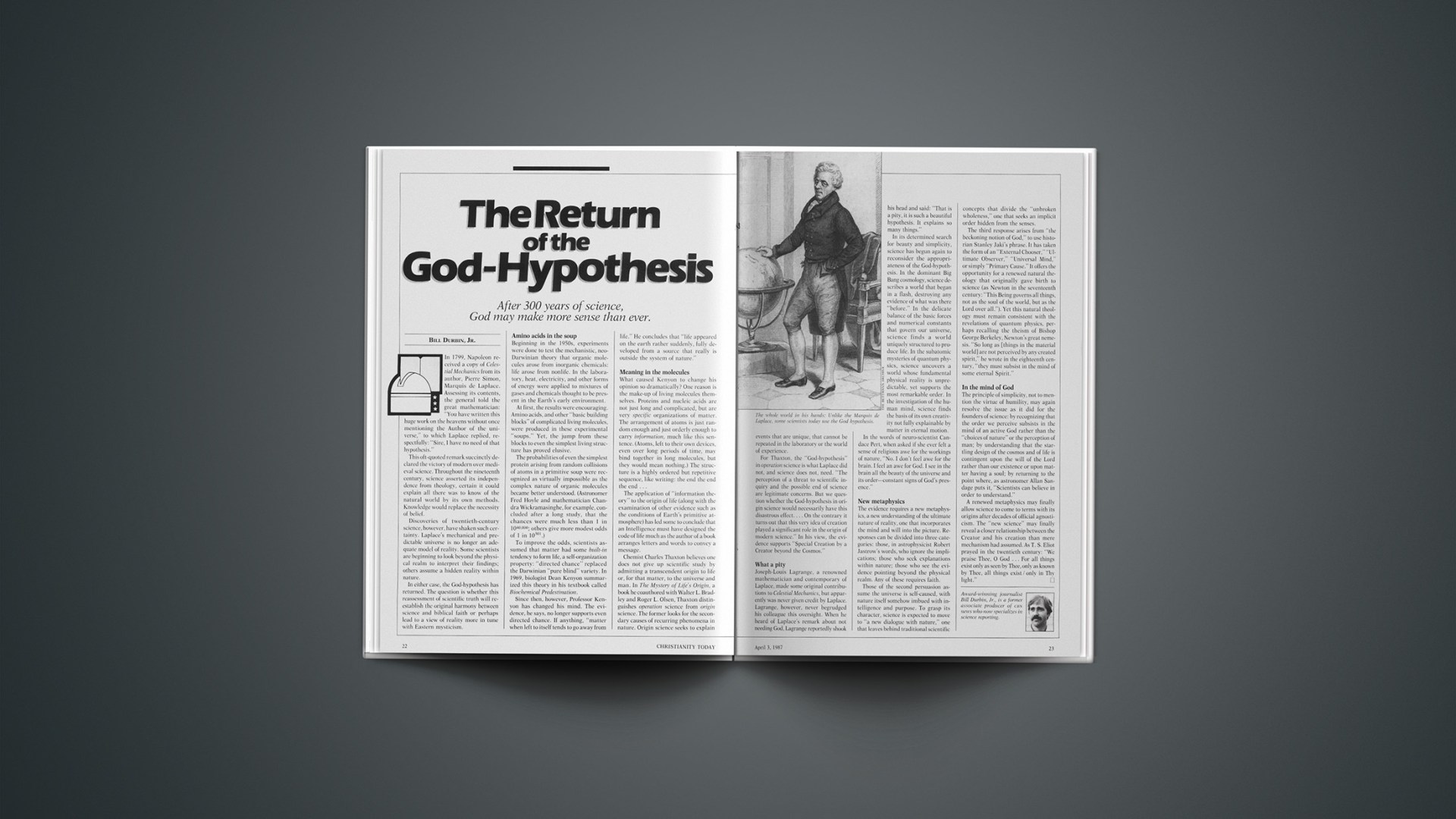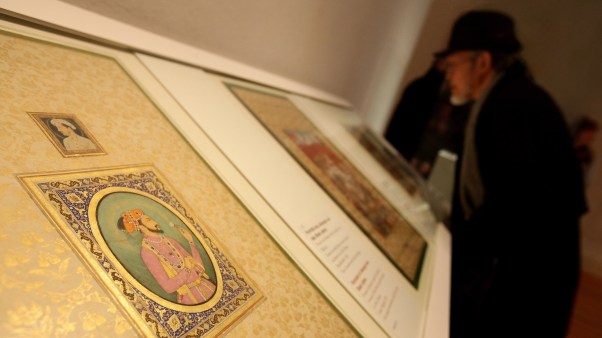In 1799, Napoleon received a copy of Celestial Mechanics from its author, Pierre Simon, Marquis de Laplace. Assessing its contents, the general told the great mathematician: “You have written this huge work on the heavens without once mentioning the Author of the universe,” to which Laplace replied, respectfully: “Sire, I have no need of that hypothesis.”
This oft-quoted remark succinctly declared the victory of modern over medieval science. Throughout the nineteenth century, science asserted its independence from theology, certain it could explain all there was to know of the natural world by its own methods. Knowledge would replace the necessity of belief.
Discoveries of twentieth-century science, however, have shaken such certainty. Laplace’s mechanical and predictable universe is no longer an adequate model of reality. Some scientists are beginning to look beyond the physical realm to interpret their findings; others assume a hidden reality within nature.
In either case, the God-hypothesis has returned. The question is whether this reassessment of scientific truth will reestablish the original harmony between science and biblical faith or perhaps lead to a view of reality more in tune with Eastern mysticism.
Amino Acids in the Soup
Beginning in the 1950s, experiments were done to test the mechanistic, neo-Darwinian theory that organic molecules arose from inorganic chemicals: life arose from nonlife. In the laboratory, heat, electricity, and other forms of energy were applied to mixtures of gases and chemicals thought to be present in the Earth’s early environment.
At first, the results were encouraging. Amino acids, and other “basic building blocks” of complicated living molecules, were produced in these experimental “soups.” Yet, the jump from these blocks to even the simplest living structure has proved elusive.
The probabilities of even the simplest protein arising from random collisions of atoms in a primitive soup were recognized as virtually impossible as the complex nature of organic molecules became better understood. (Astronomer Fred Hoyle and mathematician Chandra Wickramasinghe, for example, concluded after a long study, that the chances were much less than 1 in 1040,000; others give more modest odds of 1 in 10301.)
To improve the odds, scientists assumed that matter had some built-in tendency to form life, a self-organization property: “directed chance” replaced the Darwinian “pure blind” variety. In 1969, biologist Dean Kenyon summarized this theory in his textbook called Biochemical Predestination.
Since then, however, Professor Kenyon has changed his mind. The evidence, he says, no longer supports even directed chance. If anything, “matter when left to itself tends to go away from life.” He concludes that “life appeared on the earth rather suddenly, fully developed from a source that really is outside the system of nature.”
Meaning in the Molecules
What caused Kenyon to change his opinion so dramatically? One reason is the make-up of living molecules themselves. Proteins and nucleic acids are not just long and complicated, but are very specific organizations of matter. The arrangement of atoms is just random enough and just orderly enough to carry information, much like this sentence. (Atoms, left to their own devices, even over long periods of time, may bind together in long molecules, but they would mean nothing.) The structure is a highly ordered but repetitive sequence, like writing: the end the end the end …
The application of “information theory” to the origin of life (along with the examination of other evidence such as the conditions of Earth’s primitive atmosphere) has led some to conclude that an Intelligence must have designed the code of life much as the author of a book arranges letters and words to convey a message.
Chemist Charles Thaxton believes one does not give up scientific study by admitting a transcendent origin to life or, for that matter, to the universe and man. In The Mystery of Life’s Origin, a book he coauthored with Walter L. Bradley and Roger L. Olsen, Thaxton distinguishes operation science from origin science. The former looks for the secondary causes of recurring phenomena in nature. Origin science seeks to explain events that are unique, that cannot be repeated in the laboratory or the world of experience.
For Thaxton, the “God-hypothesis” in operation science is what Laplace did not, and science does not, need. “The perception of a threat to scientific inquiry and the possible end of science are legitimate concerns. But we question whether the God-hypothesis in origin science would necessarily have this disastrous effect.… On the contrary it turns out that this very idea of creation played a significant role in the origin of modern science.” In his view, the evidence supports “Special Creation by a Creator beyond the Cosmos.”
What a Pity
Joseph-Louis Lagrange, a renowned mathematician and contemporary of Laplace, made some original contributions to Celestial Mechanics, but apparently was never given credit by Laplace. Lagrange, however, never begrudged his colleague this oversight. When he heard of Laplace’s remark about not needing God, Lagrange reportedly shook his head and said: “That is a pity, it is such a beautiful hypothesis. It explains so many things.”
In its determined search for beauty and simplicity, science has begun again to reconsider the appropriateness of the God-hypothesis. In the dominant Big Bang cosmology, science describes a world that began in a flash, destroying any evidence of what was there “before.” In the delicate balance of the basic forces and numerical constants that govern our universe, science finds a world uniquely structured to produce life. In the subatomic mysteries of quantum physics, science uncovers a world whose fundamental physical reality is unpredictable, yet supports the most remarkable order. In the investigation of the human mind, science finds the basis of its own creativity not fully explainable by matter in eternal motion.
In the words of neuro-scientist Candace Pert, when asked if she ever felt a sense of religious awe for the workings of nature, “No. I don’t feel awe for the brain. I feel an awe for God. I see in the brain all the beauty of the universe and its order—constant signs of God’s presence.”
New Metaphysics
The evidence requires a new metaphysics, a new understanding of the ultimate nature of reality, one that incorporates the mind and will into the picture. Responses can be divided into three categories: those, in astrophysicist Robert Jastrow’s words, who ignore the implications; those who seek explanations within nature; those who see the evidence pointing beyond the physical realm. Any of these requires faith.
Those of the second persuasion assume the universe is self-caused, with nature itself somehow imbued with intelligence and purpose. To grasp its character, science is expected to move to “a new dialogue with nature,” one that leaves behind traditional scientific concepts that divide the “unbroken wholeness,” one that seeks an implicit order hidden from the senses.
The third response arises from “the beckoning notion of God,” to use historian Stanley Jaki’s phrase. It has taken the form of an “External Chooser,” “Ultimate Observer,” “Universal Mind,” or simply “Primary Cause.” It offers the opportunity for a renewed natural theology that originally gave birth to science (as Newton in the seventeenth century: “This Being governs all things, not as the soul of the world, but as the Lord over all.”). Yet this natural theology must remain consistent with the revelations of quantum physics, perhaps recalling the theism of Bishop George Berkeley, Newton’s great nemesis. “So long as [things in the material world] are not perceived by any created spirit,” he wrote in the eighteenth century, “they must subsist in the mind of some eternal Spirit.”
In the Mind of God
The principle of simplicity, not to mention the virtue of humility, may again resolve the issue as it did for the founders of science: by recognizing that the order we perceive subsists in the mind of an active God rather than the “choices of nature” or the perception of man; by understanding that the startling design of the cosmos and of life is contingent upon the will of the Lord rather than our existence or upon matter having a soul; by returning to the point where, as astronomer Allan Sandage puts it, “Scientists can believe in order to understand.”
A renewed metaphysics may finally allow science to come to terms with its origins after decades of official agnosticism. The “new science” may finally reveal a closer relationship between the Creator and his creation than mere mechanism had assumed. As T. S. Eliot prayed in the twentieth century: “We praise Thee, O God … For all things exist only as seen by Thee, only as known by Thee, all things exist / only in Thy light.”
Award-winning journalist Bill Durbin, Jr., is a former associate producer of CBN news who now specializes in science reporting.










